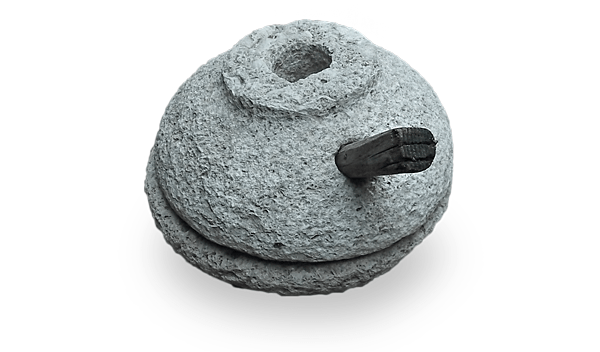
In the previous article, I’ve put a brief early stone age tools history in a nutshell before expanding on their role in extracting pure culinary Argan oil the ancestral way.
What Do Early Stone Age Tools Have To Do With Organic Culinary Argan Oil?
Well, the answer is simple!
The ancestral pure culinary Argan oil extraction method is done with a famous stone tool.
This traditional stone hand-mill, also frequently referred to with the term “R’ha” in Morocco, was used by the hard-working women for centuries or maybe even longer for the basic objective of grinding.
Yet, as far as I know, these eco-friendly and super-heavy rock-slabs can´t be traced back to a specific ‘year zero’ or any earliest cultural evidence of their use especially for Culinary Argan oil production.
This very same R´ha´s freshly-ground products: pure Argan oil, and Amlou which is filled with generous amounts of roasted and ground almonds, are sold today worldwide.
In this context, the simplicity of this early technology emphasizes the unwavering effectiveness of the traditional organic culinary Argan oil extraction method.
It contadicts some so-called modern industrial perspectives that have been pursued, and recent technological extraction methods (trying to portray it as a very simple and archaic technology).
Many of these modern methods indeed aim to combine cost–benefit strategies; though, they renounce in so doing the traditional techniques and the ancestral know-how which is a key factor for premium culinary Argan oil quality.
This “modern” interpretation is unfortunately, more often than not, biased by — and rooted in– contemporary consumerism culture and its paradigms.
My aim with this piece of content is, among other things, to emphasize how variable perspectives are, especially when considered in their marketing, sales and lucrative context.
Interestingly, these perspectives are changing in the last years.
A fact which is due in part to the evidence of the quality-supremacy of the traditionally extracted pure culinary Argan oil over the current alternative mechanisms such as the mechanically extracted Argan oil.
This has provoked a reconsideration of this view in light of the very limited evidence of the new marketing paradigm against the quite rightly-privileged traditionally-extracted culinary Argan oil, especially that the latter is becoming more and more preferred by many organic Argan oil connoisseurs.
Additionally to the aficionados of culinary Argan oil, many people start to wake up and stop praising this kind of progression.
And this attitude evolves despite that theory of extraction “revolution” advocated by some “know-it-alls” and which is — by its own definition — objectively far from holding ground.
All this prompts further questions on the alleged necessity and the evolutionary significance of the new culinary Argan oil extraction methods with regard to two main issues:
- the real reasons that led to the emergence of specific Argan oil extraction processes
- and the relationships between the cosmetic as well as the beauty industries and those processes.
With all due respect to many evolutionary processes resulting in the emergence of better ways making life easier on different planes, this specific ‘alteration’ represents in my opinion poor attempts to obtain legitimacy over a well-established ancestral knack.
This well-preserved ancestral knowledge already demonstrated correct understanding of quality-preserving principles in the absence of tangible evidence against it.
The traditional Argan oil extraction method